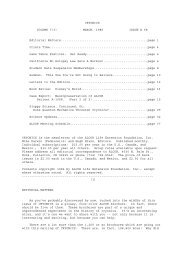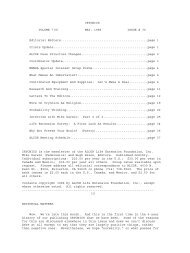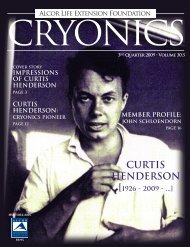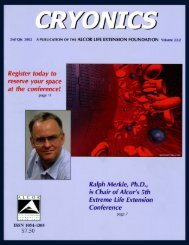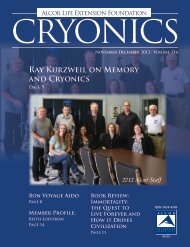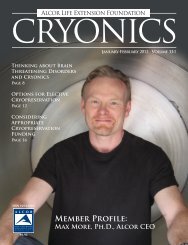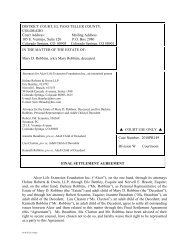Download PDF - Alcor Life Extension Foundation
Download PDF - Alcor Life Extension Foundation
Download PDF - Alcor Life Extension Foundation
Create successful ePaper yourself
Turn your PDF publications into a flip-book with our unique Google optimized e-Paper software.
Case Summary<br />
Cryopreservation of A-1097<br />
By Tanya Jones<br />
Background<br />
A long-time cryonicist, member A-1097<br />
joined <strong>Alcor</strong> in October 1985. In 1988, he was<br />
diagnosed with a Grade II astrocytoma (brain tumor).<br />
Remission of the cancer was sustained until<br />
2003, when his tumor reoccurred as a Grade<br />
IV astrocytoma. As he was being treated for this<br />
more serious form of his cancer, he underwent<br />
an astonishing 42 cycles of chemotherapy.<br />
This member was a resident of northern<br />
California until moving to Australia in recent<br />
years. We checked on his progress periodically<br />
but did not hear anything other than, “he’s still<br />
receiving treatment,” until December 26, 2005.<br />
He had been admitted to an Australian hospital<br />
with pneumonia and his family requested assistance<br />
in moving him to Arizona for terminal<br />
care. Within a few days after entering the hospital,<br />
he was well enough to speak (and annoy<br />
his nurses). His desire for independence was evident,<br />
and it was considered a good sign.<br />
Recovered enough to travel, the member<br />
made the trip to Los Angeles in early January<br />
2006. Medical personnel and his power of attorney<br />
accompanied him from Australia and were<br />
met by a member of the <strong>Alcor</strong> team. He was<br />
then fl own to a hospice in Phoenix. He did extremely<br />
well throughout his journey and never<br />
once needed supplemental oxygen. This was<br />
a sign that his troubles with pneumonia were<br />
over.<br />
His cancer, however, was a different matter.<br />
When the member was admitted to hospice<br />
in Phoenix, he was somewhat confused<br />
and unable to communicate. This member<br />
had been a friend to many of the <strong>Alcor</strong> staff<br />
for years, and staff and friends took turns visiting<br />
him.<br />
Standby & Stabilization<br />
<strong>Alcor</strong> staff performed 24-hour observation<br />
of the patient’s condition starting on January<br />
14 and was on hand until the member’s<br />
pronouncement of legal death on January<br />
19, 2006, at 08:37 am. Within minutes, <strong>Alcor</strong><br />
had circulated the fi rst three stabilization<br />
medications and prepared to administer oxygen.<br />
In less than 20 minutes, the patient had<br />
been surrounded with ice, an IV had been<br />
placed, mechanical chest compressions were<br />
started, and the patient was being transported<br />
to <strong>Alcor</strong> in the emergency transport vehicle.<br />
Transport<br />
During the 40-minute drive to <strong>Alcor</strong>, the rest<br />
of the stabilization medications were admin-<br />
Transport Temperature (nasopharyngeal)<br />
Graph shows temperature from cardiac arrest until shortly after arrival at <strong>Alcor</strong>. CPS plus<br />
ice bath cooling began approximately 23 minutes post arrest and dropped the patient’s<br />
nasopharyngeal (nasal) temperature to 18 o C in 75 minutes.<br />
16 Cryonics/Spring 2006<br />
istered and the patient was completely covered<br />
with ice (from the ice machine on-board our<br />
emergency transport vehicle). His temperature<br />
dropped markedly during this time. Upon arrival<br />
at <strong>Alcor</strong>, his nasopharyngeal temperature<br />
had dropped to 25 o C. Note: This highlighted<br />
the effectiveness of both larger volumes of ice<br />
and the mechanical cardiopulmonary support<br />
device, which enabled faster circulation. Larger<br />
amounts of ice will be used in future transports,<br />
where possible.<br />
Prior to starting the cryoproprotection,<br />
staff attempted to dramatically lower the brain<br />
temperature quickly to prevent some of the<br />
ischemic damage that results from the length<br />
of time for surgery. However, this experimental<br />
protocol proved too slow and staff immediately<br />
reverted to the standard protocol.<br />
Washout<br />
Less than two hours after cardiac arrest blood<br />
washout began. Because of the rapid response<br />
and quality of the stabilization, staff continued<br />
oxygenation throughout the cryoprotection<br />
(started after the washout). <strong>Alcor</strong> staff noted<br />
good perfusion of the patient, as well as signs<br />
of cryoprotectant uptake almost immediately<br />
upon beginning the cryoprotection.<br />
Cryoprotection<br />
Somewhat contrary to expectations, the brain<br />
tumor was not causing problems to circulation.<br />
Unlike many previous cases, both hemispheres<br />
of the brain responded in remarkably equal<br />
fashion to the introduction of cryoprotectant.<br />
Target concentrations were achieved, and there<br />
was no sign of any negative physiological response<br />
to the procedure.<br />
www.alcor.org



